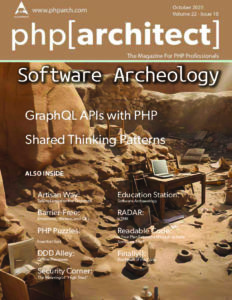Do you remember your first introduction to computing? How about what happened next? My life would be forever changed by the experience and for the better. This article will walk you through what happened next and the overall development of my code. by Christopher Miller
Enhanced simplicity and efficiency, what’s not to love? HTMX offers both; however, it also comes with some disadvantages. Let’s review the pros and cons together and determine how to make it work best for you. by Matt Lantz
There’s more than one way to sort things? We’ve looked at two basic sorting algorithms and will continue that exploration this month. Instead of comparing pairs of values in our unsorted arrays, we’ll take a different approach and use an insertion sort. by Oscar Merida
Images aren’t so clear for me. I rely on my screen reader to explain the image, whether an emoticon, sticker, or gif. I’m hoping that this process could be much easier for me and others with a little bit of understanding on the development side. by Maxwell Ivey
Clean code. Something not often associated with a typical Laravel application is it. With that Active Record database approach and the magic static calls everywhere – those used to stricter frameworks, such as Symfony, often shudder when they open a Laravel project. What if I told you it didn’t have to be like that? by Steve McDougall
This month, we are going to look at some tools, tips, and tricks to help you along as you dig through the ancient past of the historic project that you need to work on. by Chris Tankersley
This month completes our “Create Observability” series. We will design, in flowchart form, each of the queue workers. We will describe each event to be emitted by each worker. We’ll see a webpage useful for observing queues and events, thus providing observability. As we saw last month, the flowcharts document the business process so that it does not become unknown “tribal knowledge”. Finally, we’ll discover that the final queue contains precisely what our stakeholders need for customer service resolution. by Edward Barnard
When many people think about security, they naturally think about entities attacking from the outside. This might be the outside of their application, network, or even organization. We often fail to realize that the most critical threat is often users already inside your system. by Eric Mann
When You Get Home After a Workday, You May Often Want to Unwind to One of Your Favorite Video Games to Relax. As a Player, You Usually Pay Attention to Two Main Aspects of the Game. Those Being Its Mechanics and Art. You Marvel At the Technical Expertise of the Programmers Who Turned Fantastical Concepts Into a Playable Reality. Simultaneously, You Admire the Dedication to Details That Artists Incorporated As They Breathed Life Into a Virtual World. by Sydney Reinert
This article is your passport to the world of GraphQL in PHP. We’ll embark on a journey through each aspect of GraphQL, from its basics to advanced techniques. You’ll discover how to set up your development environment, define schemas, write resolvers, and handle queries and mutations with PHP. We’ll dive deep into security with authentication and authorization, and you’ll learn to manage errors and optimize queries. Real-world examples and case studies will showcase practical applications. We’ll wrap up with best practices, testing, and a plethora of resources. Get ready to master GraphQL in PHP and build efficient, flexible APIs. by Sarah Aburu




Leave a comment
Use the form below to leave a comment: